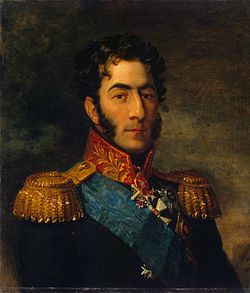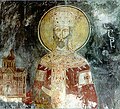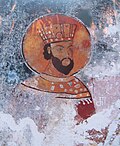Bagrationi dynasty
This article has an unclear citation style. (January 2025) |
| Bagrationi ბაგრატიონი House of Bagrationi | ||
|---|---|---|
Style(s) see list | | |
| Deposition | 1801/1810 | |
| Cadet branches | Mukhrani Gruzinsky Davitashvili Imeretinsky | |
| Part of a series on the |
| History of Georgia |
|---|
 |
The Bagrationi dynasty (/bʌɡrʌtiˈɒni/; Georgian: ბაგრატიონი, romanized: bagrat'ioni [ˈbäɡɾätʼio̞n̪i]) is a royal dynasty which reigned in Georgia from the Middle Ages until the early 19th century, being among the oldest extant Christian ruling dynasties in the world. In modern usage, the name of the dynasty is sometimes Hellenized and referred to as the Georgian Bagratids, also known in English as the Bagrations.
The
After
Origins
The earliest Georgian forms of the dynastic name are Bagratoniani, Bagratuniani[3] and Bagratovani, changed subsequently into Bagrationi. These names as well as the Armenian Bagratuni and the modern designation Bagratid mean "the children of Bagrat" or "the house of/established by Bagrat", Bagrat being a given name of Iranian origin.[4] The origins of the Bagratid dynasty is still matter of debate between Georgian and Armenian scholars. Georgian scholars argue that the Bagrationis were of Georgian origin, while Armenian and Western scholars believe them to be a branch of the Armenian Bagratunis.[5]
According to a tradition first recorded in the work of the 11th-century Georgian chronicler
This tradition enjoyed a general acceptance until the early 20th century.
The generation-by-generation history of the Bagrationi dynasty begins only in the late 8th century.[1] Toumanoff claimed that the first Georgian branch of the Bagratids may be traced as far back as the 2nd century AD, when they were said to rule over the princedom of Odzrkhe in what is now southern Georgia.[14] The Odzrkhe line, known in the medieval annals as the Bivritianis, lasted until the 5th century AD. They cannot, however, be considered the direct ancestors of the later Bagratids who eventually restored Georgian royal authority.[15] Pavle Ingorokva suggested that the Bagrations were a branch of the Pharnavazid dynasty of the Kingdom of Iberia.[16][17]
History
Early dynasty
The Bagrationi family had grown in prominence by the time the Georgian monarchy (
Despite the revitalization of the monarchy, Georgian lands remained divided among rival authorities, with Tbilisi remaining in
Golden Age
This unified monarchy maintained its precarious independence from the Byzantine and
In spite of repeated incidents of dynastic strife, the kingdom continued to prosper during the reigns of
Downfall
The invasions by the
During the three subsequent centuries, the Georgian rulers maintained their perilous autonomy as subjects under the Turkish Ottoman and Persian Safavid, Afsharid, and Qajar domination, although sometimes serving as little more than puppets in the hands of their powerful suzerains.[1] In this period, in order to receive investiture from their suzerains, as a necessary prequisite, many Georgian rulers converted to Islam.[21] Individuals from the Georgian royal family and nobility were frequently chosen for prominent administrative roles within the Safavid state.[22] Members of the Muslim royals from the Bagrationi dynasty, amongst others, held the esteemed position of darugha ("prefect") of the Safavid royal capital of Isfahan for an extensive period spanning over 100 years, from 1618 to 1722.[22] Despite being seated in Kartli starting from 1632, Rostom Khan, in particular, served as Isfahan's darugha for 40 years.[22] Additionally, he appointed deputies to represent him in the Safavid capital.[22]
The line of Imereti, incessantly embroiled in civil war, continued with many breaks in succession, and the kingdom was only relatively spared from the encroachments of its Ottoman suzerains, while Kartli and Kakheti were similarly subjected to its Persian overlords, whose efforts to annihilate the fractious vassal kingdoms were in vain, and the two eastern Georgian monarchies, survived to be reunified in 1762 under King Erekle II, who united in his person both the Kakhetian and Kartlian lines, the latter surviving in male descent in the branch of Mukhraneli since 1658.[1]
Last monarchs

In 1744, Erekle II and his father Teimuraz II were granted the kingships of Kakheti and Kartli respectively by their overlord Nader Shah, as a reward for their loyalty.[23] Following Nader Shah's death in 1747, Erekle II and Teimuraz II capitalized on the eruption of instability, and declared de facto independence. After Teimuraz II died in 1762, Erekle II succeeded his father as ruler of Kartli, and united the two kingdoms in a personal union as the Kingdom of Kartli-Kakheti, becoming the first Georgian ruler to preside over a politically unified eastern Georgia in three centuries.[24] At about the same time, Karim Khan Zand had ascended the Iranian throne; Erekle II quickly tendered his de jure submission to the new Iranian ruler, however, de facto, he remained autonomous throughout the entire Zand period.[25][26]
Erekle II (Hercules) achieved a degree of stability in Kartli-Kakheti and established political hegemony in eastern
After the death of Erekle in 1798, his son and successor, King
On September 12, 1801, Emperor Alexander I of Russia formally re-affirmed Paul’s determination, deposing the Bagrationi dynasty from the Georgian throne.[1][31] Although divided among themselves, some of the Bagrationi princes resisted Russian annexation, trying to instigate rebellion. Most of them were subsequently arrested and deported from Georgia.[32]
The reign of the House of Imereti came to an end less than a decade later. On April 25, 1804, the Imeretian king
Bagrationi in Russia

In the
Bagrationi today
The majority of the Bagrationi family left Georgia after the Red Army took over Tbilisi in 1921.[1]
Mukhrani branch
The House of Mukhrani is the most senior patrilinear branch of the Bagrationi dynasty,[1] descending directly from King Constantine II of Georgia. Originally a cadet branch of the former Royal House of Kartli, they became the genealogically seniormost line of the Bagrationi family in the early 20th century; and although this elder branch had lost the rule of Kartli by 1724,[1] it retained the Principality of Mukhrani until its annexation by Russia, along with Kartli-Kakheti, in 1800.[1]
This branch of the family is related to the
In 1942 Prince
Beginning in the 1990s, senior members of the Bagrationi-Mukhraneli descendants began
Gruzinsky branch
The Bagration-Gruzinsky line, although junior to the Princes of Mukhrani genealogically, reigned over the kingdom of
Prince
Nugzar was a theatrical and cinema director, while his father, Prince Petre Bagration-Gruzinski (1920–1984), was a poet, and authored "Song of Tiflis".[citation needed]
As Nugzar had no male issue, Prince Evgeny Petrovich Gruzinsky (1947-2018), the great-great-grandson of Bagrat's younger brother
Imereti branch
Various sources present three different lines as the head of the House of Imereti, potential claimants to the long-defunct Kingdom of Imereti, the last of the three Georgian kingdoms to lose its independence in 1810. The male line descending from the deposed David II of Imereti became extinct in 1978 when Prince Constantine Imeretinski died. He was survived by three daughters of his older brother.[citation needed]
However, Prince
The third claim names another branch descending from Prince Bagrat's younger natural son. This line survives in the male line and is headed by Prince David Bagrationi (born 1948) (not to be confused with his younger namesake from the Mukhrani branch).[48][49]
The current claimant is Irakli Davitis Dze Bagrationi (Georgian: ირაკლი დავითის ძე ბაგრატიონი), head of the Georgian scion of the royal Bagrationi dynasty of Imereti, the direct male-line descendant of the kings of Imereti, the direct descendant of Alexander V (Georgian: ალექსანდრე V) (c. 1703/4 – March 1752), of the Bagrationi Dynasty, King of Imereti (western Georgia). Irakli is a son of David Bragationi and Irina Kobakhidze, born 10 July 1982 in Terjola, Imereti, Georgia. He is the future successor and head of the House of Bagrationi-Imereti. Irakli has been recognized by the
Union of Bagrationi branches
The dynastic significance of the wedding lay in the fact that, amidst the
Although some
Aside from his unmarried elder brother Irakli, Davit is the
Prince Davit and Princess Ana became the parents of a boy on 27 September 2011,
Gallery of some Georgian monarchs of Bagrationi dynasty
-
David IV of Georgia
-
Queen Tamar of Georgia
-
David VI of Georgia
-
Vakhtang VI of Kartli
-
Solomon I of Imereti
-
George XII
See also
- Georgian monarchs family tree of Bagrationi dynasty of Tao-Klarjeti
- Georgian monarchs family tree of Bagrationi dynasty of united Georgia
- Georgian monarchs family tree of Bagrationi dynasty of Kartli
- Georgian monarchs family tree of Bagrationi dynasty of Kakheti
- Georgian monarchs family tree of Bagrationi dynasty of Imereti
- Monarchism in Georgia
References
- ^ ISBN 0-85011-029-7
- ^ Martin, Russell. "The Treaty of Georgievsk; A Translation". Westminster College. Archived from the original on 16 March 2018. Retrieved 16 March 2014.
- ^ Stephen H. Rapp. Studies in Medieval Georgian Historiography: Early Texts and Eurasian Contexts. — Corpus Scriptorum Christianorum Orientalium. — Peeters Publishers, 2003. — Vol. 601. — P. 450—451. ""K'art'velized" branch of the Armenian Bagratuni family (as is evident from the early Georgian form of their name, Bagratuniani) — resuscitated local royal authority in the late ninth century and then assembled an all-Georgian kingdom"
- ^ Donald Rayfield (2013) Edge of Empires, A History of Georgia, ISBN 9781780230702, p. 64
- ^ Mikaberidze, p. 172
- ^ Sumbat Davitis-Dze, The Life and Tale of the Bagratids (ცხოვრებაჲ და უწყებაჲ ბაგრატონიანთა ჩუენ ქართველთა მეფეთასა), see Suny (1994), p. 349; Rapp (2003), p. 337
- ^ From the time of Justinian I, the dignity of Kouropalates (Greek: κουροπαλάτης, i.e., chancellor) was one of the highest in the Byzantine Empire, reserved usually for members of the Imperial family. Its frequent conferral upon various Georgian and Armenian dynasts attests to their importance in the politics of those times. Suny (1994), p. 348
- Vakhushti Bagrationi (c. 1745), History of the Kingdom of Georgia (აღწერა სამეფოსა საქართველოსი); a Russian translation available at ArmenianHouse.org. URL accessed on May 22. 2006.
- ^ Chisholm, Hugh, ed. (1911). . Encyclopædia Britannica. Vol. 11 (11th ed.). Cambridge University Press.
- ^ Toumanoff, C. Iberia on the Eve of Bagratid Rule, p. 22, cited in: Suny (1994), note 30, p. 349
- ^ Toumanoff, C. Iberia on the Eve of Bagratid Rule, p. 22, cited in: Suny (1994), note 30 p. 349
- ^ Rapp (2003), p. 169
- ^ Rapp (2003), p. 234
- ^ Toumanoff, C. Studies in Christian Caucasian History, p. 316, cited in: Rapp (2003), p. 145
- ^ Rapp (2003), pp. 218, 249
- ^ Mikaberidze, p. 171
- ISBN 9994012568.
- ^ Suny (1994), p. 29
- ^ "Georgia.". Encyclopædia Britannica Premium Service. Archived from the original on 2012-12-08. Retrieved 2006-05-25.
- ^ According to Prince Vakhushti, David Soslan’s ancestry traced back to the Georgian refugee prince David, a grandchild of George I of Georgia (1014–1027) and his Alan wife Alde. This continues to be disputed
- ^ Rota 2017, pp. 52–57.
- ^ a b c d Sanikidze 2021, p. 389.
- ^ Suny 1994, p. 55.
- ^ Hitchins 1998, pp. 541–542.
- ^ Fisher et al. 1991, p. 328.
- ^ Perry 1991, p. 96.
- ^ Kazemzadeh 1991, pp. 328–330.
- ^ Relations between Tehran and Moscow, 1797-2014. Retrieved 15 May 2015.
- ISBN 9639241989p 204
- ^ Lang (1957), p. 242
- ^ a b "Georgievsk, Treaty of". Encyclopædia Britannica Premium Service. Retrieved 2006-06-04.
- ^ Lang (1957), p. 252
- ^ Suny (1994), p. 64
- ^ Baddeley, Gammer (1908), pp. 66, 78
- ^ a b "La familia real (Y española) de Georgia, de luto por la muerte de su matriarca". 21 April 2020.
- ^ "Russian Imperial House - Decree of the Head of the Russian Imperial House, H.I.H. Grand Duke Wladimir Kirillovich, on the Recognition of the Royal Rank of the House of Bagration, 22 November/5 December 1946".
- ^ a b "Georgian royalty on diplomacy". 5 August 2017.
- ^ a b "Interview du prince David Bagration, héritier au trône de Géorgie".
- ^ a b "Court Circular". The Royal Family.
- ^ a b ">NEWS".
- ^ a b Marrin, Minette (2008-02-02). "Prince George Bagration of Mukhrani, Claimant to the throne of Georgia who became well known in Spain as a motor racing and rally driver". The Times. London. Archived from the original on May 23, 2010. Retrieved 2008-02-09.
- ^ ">Genealogy".
- ^ a b "Wedding of the two royal dynasties members". Georgia Times. 8 February 2009. Archived from the original on 13 February 2009. Retrieved 9 February 2009.
- ^ a b "გარდაიცვალა რეჟისორი და მსახიობი ნუგზარ ბაგრატიონ-გრუზინსკი". Georgian Public Broadcaster (in Georgian). Retrieved 2025-03-01.
- ^ a b "ნუგზარ ბაგრატიონ-გრუზინსკი (1950-2025)". National Parliamentary Library of Georgia; Biographical dictionary. Retrieved 2025-03-01.
- ^ a b The Legal Heir to the Royal Throne of the Georgian Bagrationi Dynasty. Retrieved 2013-08-02.
- ^ BAGRATION genealogy. Retrieved 2013-11-08.
- ^ ბაგრატიონები: სამეცნიერო და კულტურული მემკვიდრეობა, იმერეთის მეფეები ბაგრატიონთა დინასტიიდან, თბილისი, 2003 The Bagrations: Scientific and Cultural heritage, Kings of Imereti from Bagrationi dynasty, Tbilisi, 2003
- ^ იმერელი ბაგრატიონების ოჯახი. Retrieved 2013-11-11.
- ^ ბაგრატიონები: სამეცნიერო და კულტურული მემკვიდრეობა, იმერეთის მეფეები ბაგრატიონთა დინასტიიდან, თბილისი, 2003 The Bagrations: Scientific and Cultural heritage, Kings of Imereti from Bagrationi dynasty, Tbilisi, 2003 ვინ ერეოდა ირაკლი ბაგრატიონის ცხოვრებაში აქტიურად და რატომ არ ქმნის ის ოჯახს თბილისელები Magazine "Tbiliselebi" Retreind 2022-10-27.
- ^ "GeorgiaTimes.info". 2009-02-13. Archived from the original on 2009-02-13. Retrieved 2024-08-07.
- ^ a b Vignanski, Misha. (in Spanish) El Confidencial, Spain. Primera boda real en dos siglos reagrupa dos ramas de la dinastía Bagration (First royal wedding in two centuries reunites the branches of the Bagrationi dynasty). 2 August 2009 (retrieved 25 November 2013).
- ^ a b Time for a King for Georgia?
- ^ "Russian Imperial House - Decree of the Head of the Russian Imperial House, H.I.H. Grand Duke Wladimir Kirillovich, on the Recognition of the Royal Rank of the House of Bagration, 22 November/5 December 1946".
- ^ "Royal Birth". Royal House of Georgia. 2011-09-28. Archived from the original on 2013-11-05.
Sources
- Mikaberidze, A. (2015) Historical Dictionary of Georgia, ISBN 9781442241466
- Baddeley, JF, Gammer M (INT) (2003), The Russian Conquest of the Caucasus, Routledge (UK), ISBN 0-7007-0634-8(First published in 1908; 1999 edition, reprinted in 2003)
- Lang, DM (1957), The Last Years of the Georgian Monarchy: 1658-1832, New York: Columbia University Press.
- Fisher, William Bayne; Avery, P.; Hambly, G. R. G; Melville, C. (1991). The Cambridge History of Iran. Vol. 7. Cambridge: ISBN 0521200954.
- Hitchins, Keith (1998). "EREKLE II". Encyclopaedia Iranica, Vol. VIII, Fasc. 5. pp. 541–542.
- Kazemzadeh, Firuz (1991). "Iranian relations with Russia and the Soviet Union, to 1921". In Avery, Peter; Hambly, Gavin; Melville, Charles (eds.). The Cambridge History of Iran (Vol. 7). Cambridge University Press. ISBN 978-0521200950.
- Perry, John (1991). "The Zand dynasty". The Cambridge History of Iran, Vol. 7: From Nadir Shah to the Islamic Republic. Cambridge: Cambridge University Press. pp. 63–104. ISBN 9780521200950.
- Rapp, SH (2003), Studies In Medieval Georgian Historiography: Early Texts And Eurasian Contexts, Peeters Bvba ISBN 90-429-1318-5.
- Rota, Giorgio (2017). "Conversion to Islam (and sometimes a return to Christianity) in Safavid Persia in the sixteenth and seventeenth centuries". In Norton, Claire (ed.). Conversion and Islam in the Early Modern Mediterranean: The Lure of the Other. Routledge. ISBN 978-1317159797.
- ISBN 978-0755633807.
- ISBN 978-0253209153.
Further reading
- A. Khakhanov. "Histoire de la Georgie", Paris, 1900 (in French)
- A. Manvelichvili. "Histoire de la Georgie", Paris, 1951 (in French)
- A. Manvelishvili. "Russia and Georgia. 1801-1951", Vol. I, Paris, 1951 (in Georgian)
- K. Salia. "History of the Georgian Nation", Paris, 1983
- Kartlis Tskhovreba, vol. I-IV, Tbilisi, 1955-1973 (in Georgian)
- P. Ingorokva. Giorgi Merchule (a monograph), Tbilisi, 1954 (in Georgian)
- E. Takaishvili. "Georgian chronology and the beginning of the Bagratid rule in Georgia".- Georgica, London, v. I, 1935
- Sumbat Davitis dze. "Chronicle of the Bagration's of Tao-Klarjeti", with the investigation of Ekvtime Takaishvili, Tbilisi, 1949 (in Georgian)
- "Das Leben Kartlis", ubers. und herausgegeben von Gertrud Patch, Leipzig, 1985 (in German)
- V. Guchua, N. Shoshiashvili. "Bagration's".- Encyclopedia "Sakartvelo", vol. I, Tbilisi, 1997, pp. 318–319 (in Georgian)
External links
- Official Site of the Royal House of Bagrationi of Georgia, Mukhrani Branch
- Official Site of the Royal House of Bagrationi of Georgia, Gruzinsky Branch
- Marek, Miroslav. "Genealogy.eu - Genealogical account of the Bagratids per Bichikashvili-Ninidze-Peikrishvili". Genealogy.EU.
- БАГРАТИОНЫ - ветвь Багратиони-Давитишвили
- ვ. გუჩუა, ნ. შოშიაშვილი ბაგრატიონები. I. Abashidze Main Scientific Editorial Office of the Georgian Encyclopedia, Georgian National Academy of Sciences












